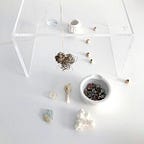Biomimicry | Cyclical Reflections
With a studio practice that extends across disciplines and originated with a childhood spent examining natural forms, the topography of farm fields, as well as marine specimens in my grandparents’ science collections, a recent deep dive into the inner workings of biomimicry seemed essential this past summer while based near the sea in Italy.
I initially had reservations about what I thought might be a more extractive approach to design innovation based on the ‘genius of nature’, but a series of smart online courses with Learn Biomimicry (based in South Africa) guided me towards ideas, processes, and resources that were more about resilient and regenerative models and systems than the imitation of or mimicking of nature’s species and forms.
My summer research focused primarily on how biomimicry principles highlight the efficiency of animal/plant species and their systems and what investigative dialogues might be explored via slow crafting strategies and handmade tools or structures.
Examples of complex fiber-like connectivity or aggregate compositions in nature, at a nano or micro scale specifically, has prompted new materials studies for cyclical design ideas as well.
Ironically, my earliest works on paper studies touched on some of this thinking, where collaged and drawn fragments were layered to show similarities between forms, in ways that were more about suggesting a language of adaptive resiliency and seemingly invisible intersections.
These intersections are where I hope to continue with projects/research, particularly in relation to atmosphere and cloth, terrain documentation, and environmental narratives that are site and species specific as well.
- A favorite resource from the Learn Biomimicry journal is this timeline of historic examples of biomimicry solutions and design strategies.
- Learn Biomimcry’s course work and practitioner studies training programs are findable here.
